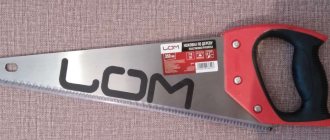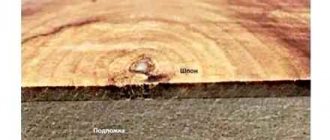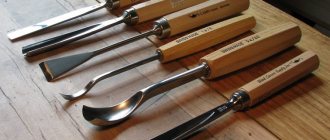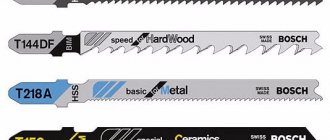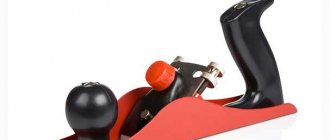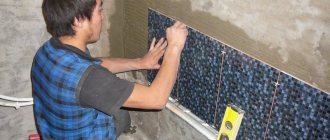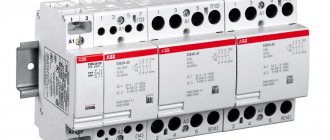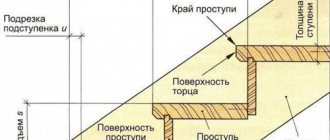One of the ways to influence wood is cutting or sawing. These types of processing are used almost from the very beginning of working with the material.
The standing wood is cut and later sawn into graded lumber. Then, directly at the workplace, the lumber is sawed more than once. For this purpose, circular saws are often used, the main working part of which is the disk.
Types of saws
Depending on the working tool used, saws can be divided into several types:
- chain;
- tape;
- saber;
- disk.
As the name implies, chain saws act on the material with sharply sharpened teeth of a complex configuration, which are connected into one endless chain. It is mounted on a special tire and driven by an internal combustion engine or an electric motor.
The design of band saws uses steel bands with cut and sharpened teeth. They are used in large stationary units used in sawmilling.
Reciprocating saws are mechanical devices that are a fairly rigid steel blade with saw teeth, which acts on wood when performing reciprocating movements like a hand saw. This blade is driven by an electric motor through a special gearbox.
Circular saws are so called because their working body is a wood saw blade, which directly acts on the material during the processing process.
Circular jointer (ROM on the shafts.) Measurement with a tachometer
Measuring with a mechanical tachometer requires direct contact with the surface of the object.
Drive unit. The best option is a V-belt. You can use a poly-V-ribbed drive belt complete with pulleys from a car engine. The belt drive guarantees a certain safety when the disc becomes jammed (for example, a nail in a workpiece). Unlike a rigid gear drive, the belt will slip on the pulley, preventing the circular disk .
If the electric motor does not have a speed controller, replacement pulleys of different diameters can be made. This will make it possible to use disks of all types, at different operating speeds.
Shaft. Perhaps the most important part of a homemade circular saw . It is not safe to make handicrafts from a piece of pipe, so it is better to order it from a good turner or buy it ready-made. The same goes for mounting for bearings. To save money, you can use hub kits from your car.
Bearings must be protected from dust; for this purpose, a gasket casing is installed in the grooves between the bearing races. The shaft may have slots with fastenings for plane knives. In this case, it must be balanced. It can also be equipped with mounts for cutters. Then the machine will be able to produce paneled doors and cornices of complex shapes.
Electrical part. The starting device must match the power of the electric motor. The safest option is a push-button one, with thermal protection against overcurrent. In this case, if the disk jams, automatic shutdown is possible. The electrical panel is mounted on a dielectric material, the wiring is reliably insulated from the metal frame. The shutdown button is located in an accessible place and should be pressed without force.
Often such machines are stored outside. Therefore, the electrical part must be protected from direct moisture. When designing a homemade circular saw, it is necessary to provide for the possibility of its repair, maintenance, and replacement of worn parts.
Moving parts must be lubricated. Before practical work, drawings are made, which include every detail. Any error in manufacturing entails the purchase of new material, which will inevitably increase the cost of the structure.
Application of disks
Saw blades look like circular wood saws. They are installed and secured on a rotating drive. Depending on how the sawing process is carried out, circular saws can be divided into two types:
- saws with a fixedly mounted shaft on which the saw blade is fixed. In such tools, the circle rotates in one place, and a wooden blank is fed to the working body;
- saws that themselves move towards wooden workpieces. When working with such tools, the workpiece is usually fixed motionless, and the circular saw moves, making the necessary cut.
The first type includes various stationary circular saws and sawmill equipment. The second type includes hand-held circular saws, so-called parquet saws, and various mini-cutters with a circular working tool.
What speed is needed for a circular
Do-it-yourself circular saw – durable, convenient, inexpensive!
For any home craftsman, having your own stationary sawing machine is time saving and work safety. You can purchase a ready-made stationary circular. The price of small machines starts from 9,000 rubles, more or less reputable stationary saws are sold in the price range from 30 to 100 thousand.
Despite the apparent complexity of the design, any craftsman with simple plumbing skills can make a homemade circular saw. Moreover, during the design process it is possible to add functions not provided by the manufacturer.
Parameters and characteristics
Saw blades differ in design: solid, made of tool steel, and combined, with surfaced or welded carbide elements made of steel with the addition of tungsten carbide or cobalt.
Solid wheels are easy to sharpen, inexpensive and therefore used very often. Combined discs are much more expensive, but they are good because they are durable and reliable, do not require tooth alignment, and allow you to cut wood at high speed without requiring frequent sharpening.
The main parameters of saw blades are:
- outside diameter;
- number of teeth;
- tooth inclination;
- tooth shape;
- disc thickness;
- diameter of the mounting hole.
When choosing a tool, each of their parameters is taken into account.
Disc diameter
The outer diameter is measured between the outermost points. Typically this is the distance between the two tips of opposing teeth. The external size is determined by the characteristics of the cutting tool on which the saw blade will be installed. This size affects the thickness of the wooden blanks that need to be sawed, or the required cutting depth.
Number of teeth
The speed of cutting wood and, accordingly, the cleanliness of the processing depends on the number of teeth on the cutting wheel. If the teeth are large and their number is small, the cutting speed can be very high, since in this case the chips are very well removed from the cutting area. But at the same time the cut turns out to be rough. Such consumables are usually used for tools and machines when producing large volumes of work, where the quality of processing is not important. This could be sawmill equipment, sawmills, or circular saws.
If there are a large number of small teeth on the disk, the cutting speed is significantly reduced, but the cut surface is much cleaner. Such circles are often used in hand tools for the manufacture of wood products and interior elements.
Incline
The angle of the tooth is the angle formed between the surface of the leading cutting edge and a line running along the radius of the saw wheel. It is customary to divide tooth inclination into three ranges.
A positive tilt, in which the tooth seems to run over, grabs the workpiece of wood, aggressively biting into it. The angle of inclination of the leading edge is 15-20 degrees. The number of teeth on disks with such teeth is usually small and they are used for quick and rough sawing of wood.
A negative angle is when the tooth begins to engage the wood from its base, continuing to cut with the entire edge all the way to the top, cutting into the wood. This tilt ranges from 0 to -5 degrees. As a rule, such teeth are installed on solid steel disks.
The normal or standard tooth angle is 5-15 degrees. This inclination is considered universal, and discs with such teeth are used in many jobs.
Configuration
The shape of the teeth can be different. Both the speed and quality of sawing wood depend on it. Depending on the configuration, the teeth are flat, with a replaceable inclination, combined and with enlarged lateral inclined incisors.
Flat cutters are the simplest type, which is used for quick longitudinal cutting of high and low density wood.
Variable bevel cutters have cutting edges that alternately change in one direction or the other. Such discs are used for sawing wood along or across the grain. Thanks to the sharpening feature, such cutters can easily process plywood, chipboard and oriented strand board.
Combination cutters can make cuts very quickly. The cutter here consists of several teeth combined into groups. Each group usually has five incisors. Four of them have a removable inclination alternately in one direction and the other, and the 5th incisor is flat. Saw wheels with such cutters are universal; they can be used for sawing any wood materials.
For sawing materials prone to splitting, there are cutting wheels with cutters with enlarged inclined sides. These same discs are also used for quick finishing sawing.
Disc thickness
The area of its application depends on the thickness of the disk. The thicker the blade, the wider the cut. To work in such a circle, a more powerful drive is needed. The thickest blades are for circular saws for wood. When sawing long workpieces, especially along the grain, very often some distortion and jamming of the blade is possible. The thin disk may overheat and burst. Very often, thick, large-diameter discs are used for cross-cutting (or end-cutting). Sometimes such circles are even used for sawing firewood. The wood disc for a circular saw usually has a thickness of 3.2 mm.
If you need a thin and neat cut, it is better to use discs with a thickness of 1.8 mm or more. They are usually used on hand-held cutting tools for woodworking.
There are many more miniature tools for very small jobs. These are various universal drives with replaceable working bodies. The set of such tools necessarily includes several ultra-thin saw blades for wood with a thickness of only 0.8-1.0 mm. Their diameter is very small and ranges from 20 to 65 mm.
The diameter of the mounting hole depends on the tools and equipment with which the saw blade will be used.
How to make a circular, maintaining a balance between economy, functionality and safety
Bed. The frame can be made from an iron angle (channel) purchased from scrap metal collectors. If you have the means, contact a metal warehouse. The legs can be made from old water pipes, connecting them with corners.
You need to use electric welding. Be sure to strengthen the corner joints with a jib. The upper part of the frame (on which the table will rest) and the podium for the electric motor are made from a corner with a side of at least 50 mm. If the machine is equipped with wheels for movement, they must have iron rims and have locks. The higher the weight of the frame, the more stable the machine will be, and the safer the work will be.
Table. The working surface is made of iron, aluminum or silumin sheet. It is permissible to use textolite, plexiglass or moisture-resistant plywood. Zinc-coated sheet metal is placed on top of the plywood. The main condition is that the material should not burst from vibrations, have a smooth surface and not allow deflections under a weight of more than 50 kg. If the tabletop cracks or warps, the circular disk will jam.
This will lead to injury and damage to the workpiece. The introduction of popular materials OSB and chipboard is not necessary. These materials are unstable to vibrations and can collapse at the most crucial moment.
There are two options for producing a working groove for a circular disk . You can cut a groove or place two halves of the tabletop at a distance from each other. The disk should protrude above the table by no more than 1/3 of its diameter.
Marking of saw blades and its interpretation
All products currently produced usually display the logo and brand of the manufacturer. This is usually the largest and most striking element of the marking, which is important only to make it easier to remember the brand of the product you like.
Much more important information can be obtained from the remaining elements of the marking. The main dimensions of the product in millimeters must be depicted on the surface of the saw blades. For example,
140 x 2.5 x 20,
where 140 is the outer diameter of the circle, 2.5 is the thickness of the disk, 20 is the diameter of the mounting hole.
The second mandatory value displayed on the product is the maximum rotation speed at which it is possible to safely use the saw blade. It is measured in revolutions per minute, which the cutting tool shaft makes when rotating. For example,
n<6500 rpm.
In addition to this basic information, the surface may describe the area of application of the blade using words or pictograms, schematically depict the shape of the teeth, indicate the direction of rotation and indicate the speed at which different types of wood should be cut.
Criterion 4.
Marking
Inscriptions and pictograms printed on the disc using laser technology (and not with ordinary paint, which is important) are a storehouse of basic information about this product. As such, there are no standards here; each manufacturer is free to indicate only what it considers necessary. However, it is the marking that allows you to navigate as best and quickly as possible both when choosing a disk and during its operation - which is why application with ordinary paint is highly discouraged
. As a rule, on the body of the disk you can read/see:
- brand
; - model
; - parameters
, including thickness, outer and bore diameter; - possibility of installing
a washer; - number of teeth
; - purpose
(for a machine, for a hand tool); - limitation in application
(for wood, for aluminum, etc.); - maximum
number of revolutions; - direction of disk rotation
.
The most significant nuances are often duplicated, presented both in the form of text and in the form of icons. This is most convenient for the buyer, because schematic images are not always easy to decipher, and is practical in the process of using the equipment.
